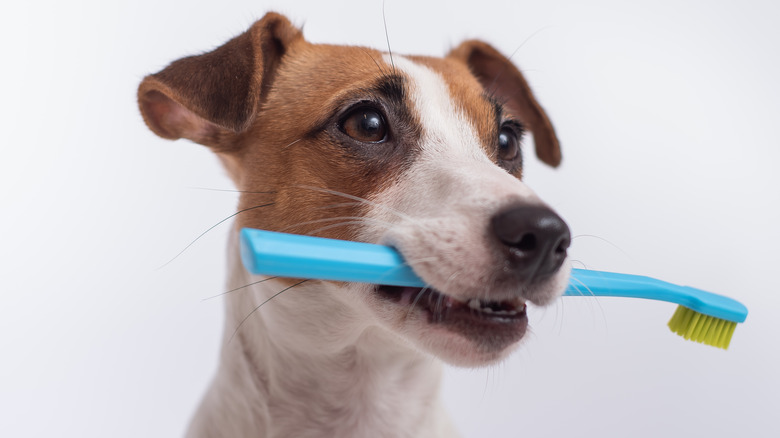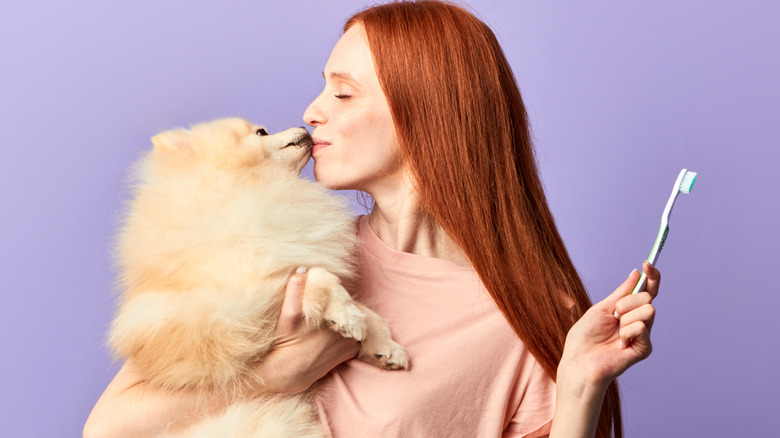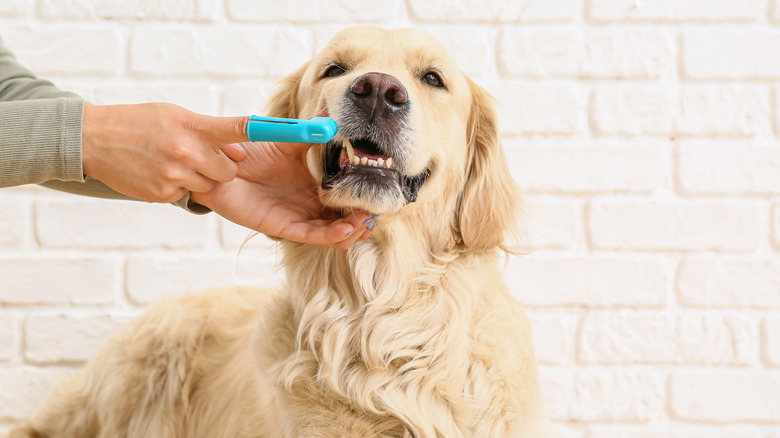Should You Be Brushing Your Dog's Teeth?
When you don't brush your teeth, problems naturally ensue. Just like their human companions, pets are prone to cavities and other dental health problems. Periodontal disease, or gum disease, affects around 80% of dogs, according to a 2018 study published in PLoS One. Smaller dogs, as well as those of older age, are more likely to develop this condition. The disease starts as gingivitis, or gum inflammation, and can become chronic over time. Aging and nutritional deficiencies seem to play a major role in its onset.
As the study notes, gum disease may increase the risk of hepatitis, chronic bronchitis, and cardiovascular problems in dogs. Oral bacteria can cause small abscesses in the liver and kidneys or make their way to the heart, causing organ damage. Moreover, dogs' saliva is more alkaline than that of humans, which promotes plaque buildup, per WebMD. Dental plaque accumulation can lead to bacteria growth, which in turn may cause gum inflammation and tooth loss.
Considering these aspects, it makes sense to take care of your dog's teeth and check for signs of dental disease, such as red or swollen gums, bad breath, or bloody saliva. This brings up the question: Should you brush your dog's teeth, and, if so, how often?
Make a habit out of brushing your dog's teeth daily
Experts agree that daily tooth brushing is the best way to prevent gum disease, but most pet parents ignore this aspect, according to clinical research published in PLoS One. Ideally, you should brush your dog's teeth every day to slow the progression of gingivitis, or at least three times per week to keep his mouth healthy. This simple habit helps remove plaque and prevents it from building up on your pet's teeth, protecting against dental health problems, according to VCA Animal Hospitals.
Pet treats and toys that claim to improve dental health cannot replace a thorough cleaning, explains the American Veterinary Medical Association. Daily tooth brushing, on the other hand, can reduce or eliminate the need for professional dental cleanings. The problem is that some pet owners cannot handle the dog's mouth or simply don't know how to brush properly. Plus, they simply may not realize the risk of dental disease (via Frontiers in Veterinary Science).
The MSD Veterinary Manual recommends brushing your dog's teeth on a daily basis. If that's not an option, you can use a gauze pad to wipe the surface of his teeth every two or three days. Note that tooth brushing may exacerbate pain in dogs with swollen gums. Additionally, it doesn't remove hardened dental plaque, or calculus. In such cases, it's best to ask your vet for specific recommendations.
How to clean your dog's teeth at home
Brushing your dog's teeth isn't rocket science, but it takes some finesse. For starters, always ensure you're not using the wrong toothpaste. The American Kennel Club recommends Petsmile, Virbac, Vetoquinal, and other brands that use vet-approved ingredients. Xylitol, an artificial sweetener in human toothpaste, can be toxic to dogs, so you should only use pet-safe options. Some brands offer dental kits that include a toothbrush, toothpaste, and other supplies, too.
The AVMA recommends applying a small amount of toothpaste on a finger and then letting your furry friend smell and taste it during the first week. Later, you can try to rub some toothpaste on their lips and gums. Give them a treat when you're done. Repeat this step for a couple of days before transitioning to a soft bristle toothbrush. Pull their lips back and brush the surface of their teeth. Hold the toothbrush at a 45-degree angle and move fast to prevent your pet from getting bored. Do it for a few seconds at a time and increase the duration over the next few weeks. Remember to praise your pet and reward them with treats for sitting still.
As a rule of thumb, store your dog's toothbrush in a dry, clean place away from your dental hygiene supplies to prevent the spread of bacteria. If you have two or more dogs, use a different toothbrush for each pet. Alternatively, you can buy one with replaceable heads and switch them as needed.


